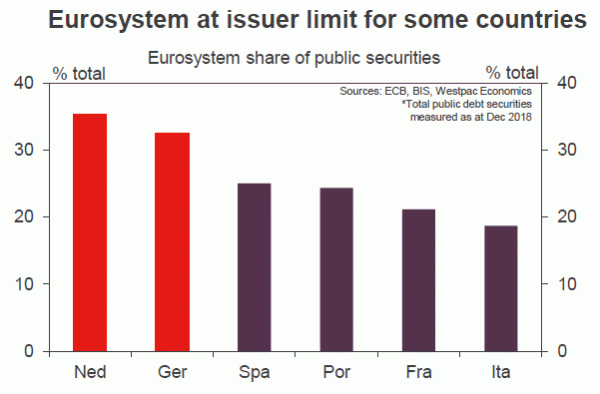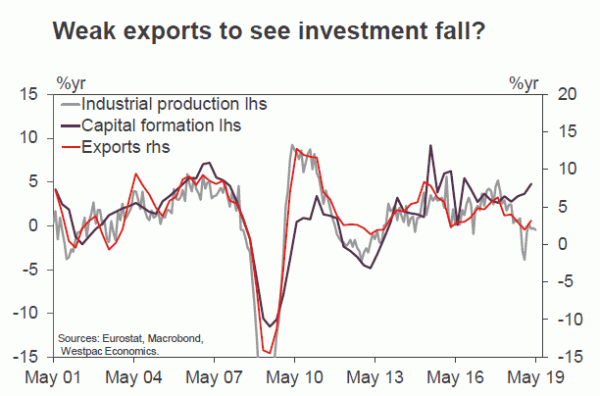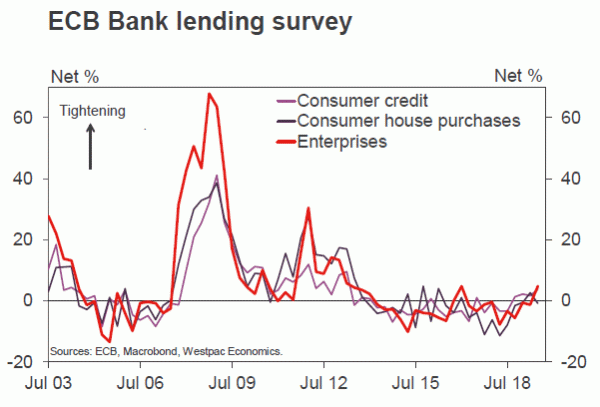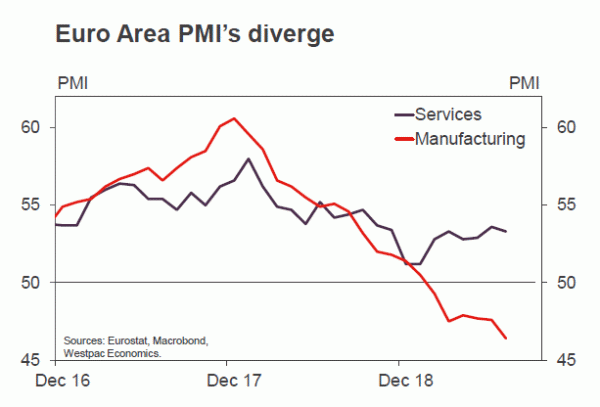The July ECB meeting largely met expectations through indicating that the deposit rate is very likely to be cut at their September 12 meeting and that other stimulus measures are on the table.
Starting with the economic outlook, as the July meeting does not involve updates to the macroeconomic projections, the section in the introductory statement was broadly similar to June but does suggest the near term growth outlook will be revised down. Here the Governing Council note data continues “to point to somewhat slower growth in the second and third quarters of this year. This mainly reflects the ongoing weakness in international trade in an environment of prolonged global uncertainties, which are particularly affecting the euro area manufacturing sector.”
That is in contrast to the June projections which envisioned a rebound in the second half of the year. Such a downgrade was reinforced in the press conference where Draghi noted that while some signs of strength can be see in the labour market, and there is resilience in the services and construction sectors, the sticking point in his message is that the outlook is getting “worse and worse”, particularly for manufacturing.
In that respect, forward guidance in the introductory statement was adjusted to the key policy rates expected to “remain at their present or lower levels at least through the first half of 2020, and in any case for as long as necessary”. The introduction of “or lower levels” ultimately reaffirms markets being fully priced for the September meeting and suggests a 10bps deposit rate cut will be delivered. Secondly, they also added “the need for a highly accommodative stance of monetary policy for a prolonged period of time”.
The detail on other potential stimulus measures is not clear cut but the Council are clearly making preparations. Importantly, discussion of other stimulus was preceded by concern over inflation: “if the medium-term inflation outlook continues to fall short of our aim, the Governing Council is determined to act, in line with its commitment to symmetry in the inflation aim”. The affirmation on the symmetry of the inflation target is new, and suggests an even greater willingness to ease policy.
Accordingly, the Governing council outline “in this context, we have tasked the relevant Eurosystem Committees with examining options, including ways to reinforce our forward guidance on policy rates, mitigating measures, such as the design of a tiered system for reserve remuneration, and options for the size and composition of potential new net asset purchases.”
Essentially, that can be taken as the Governing Council making preparations for the medium-term inflation outlook disappointing, and consequently what stimulus measures will be used to counteract that.
Preparations are in the early stages, and Draghi noted in the press conference that they wanted to give the Eurosystem Committees leeway to examine the various proposals. He did note that there were some differing opinions within the Governing Council on the exact nature of the proposals included in the introductory statement but there was of course an eventual agreement.
In terms of our own expectation, we continue to believe that a cut will be delivered in September but now expect a broader stimulus package will also be introduced. This is in response to the particularly bad run of data over recent weeks, in particular the ECB Bank Lending survey which showed a tightening in lending conditions in response to the worsening economic outlook.
We expect that the cut in September will be followed by a tiered deposit rate to mitigate the pressure on banks and that asset purchases of sovereign bonds will be restarted. Our expectation is for the ECB to introduce a €30bn per month program in December lasting for a year at this stage.
For that to occur, the ECB will need to increase their self-imposed issuer limits from the current 33% given German Bunds are already at that limit. For example, given €1.6tn of Bunds outstanding, a new issuer limit of 45% would allow room for the purchase of ~€200bn bunds, and with Bunds representing roughly 25% of purchases, that would create room for ~€800bn of total sovereign European bonds.

















